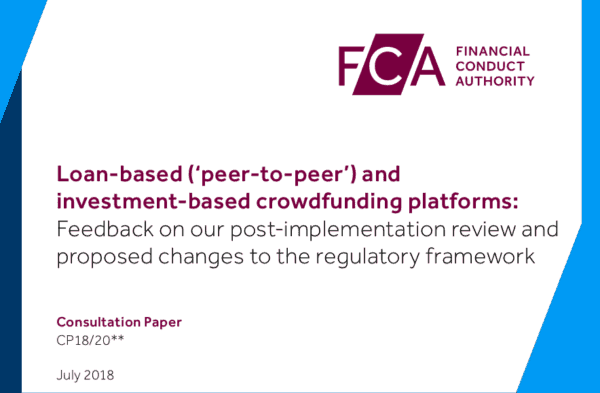Investment Crowdfunding Rules Deemed Satisfactory.
The UK Financial Conduct Authority (FCA) has finally released its long awaited post-implementation review of crowdfunding regulation. As has been widely rumored for quite some time, the FCA is looking to adjust rules governing loan based crowdfunding, also labeled peer to peer lending, while leaving the equity side, a more simple business model, largely unchanged. The FCA states they are “largely content with the regulatory framework in place for investment based crowdfunding platforms.”
The FCA announced a new consultation regarding proposed changes stating the agency has observed an evolving sector of online lending with some loan based crowdfunding models becoming increasingly complex.
Additionally, the agency said they had witnessed some “poor business practices” in the P2P sector. While some P2P lenders have more robust controls in place others are deemed inadequate and in need of “significant improvements.”
 Gillian Roche-Saunders, a partner at the law firm of Bates, Wells & Braithwaite in London and a leading regulatory consultant in the Fintech sector, had this to say about the FCA review;
Gillian Roche-Saunders, a partner at the law firm of Bates, Wells & Braithwaite in London and a leading regulatory consultant in the Fintech sector, had this to say about the FCA review;
“Today’s announcement shows a real u-turn from that very initial assumption in 2013 that P2P lending was the simpler of the regulated crowdfunding models. The FCA has truly looked under the bonnet of the industry and identified three sub-strata of lending platforms along with ancillary services that create very different experiences and risks for consumers. This will be the foundation of a much more sophisticated and targeted supervisory approach from the regulator.“
Christopher Woolard, who overseas the competition mandate at the FCA, issued a statement alongside the review;
“When we introduced new rules for crowdfunding, we said we’d review the market as it developed. We believe that loan-based crowdfunding can play a valuable role in providing finance to small businesses and individuals but it’s essential that regulation stays up to date as markets develop. The changes we’re proposing are about ensuring sustainable development of the market and appropriate consumer protections.”
As a regulator, the FCA is regarded as a sector leader when it comes to facilitating Fintech innovation. It’s light touch, principles based regulatory approach, has been a vital variable in the growth of online capital formation. The UK crowdfunding sector is, in many ways, the most robust in the world.
The FCA most recently completed a review of crowdfunding rules in 2016. At that time the agency stated;
“Our focus is ensuring that investor protections are appropriate for the risks in the crowdfunding sector while continuing to promote effective competition in the interests of consumers. Based on our findings to date, we believe it is necessary to strengthen investor protection in a number of areas. We plan to consult next year on new rules to address the issues we have identified.”
The delayed review by the FCA has been expected for quite some time with the expectation that peer to peer lending would receive targeted scrutiny.
As defined by the UK, crowdfunding takes two forms:
- Loan-based crowdfunding – usually called peer-to-peer (P2P) lending. People and institutions use these types of platforms to lend money directly to consumers or businesses, to make a financial return from interest payments and the repayment of capital over time.
- Investment-based crowdfunding – these are platforms where investors can invest directly in businesses by buying investments such as shares or debentures.
Breaking this down further, the FCA identifies three main categories:
- Conduit Platforms – The investor picks the investment opportunities and the platform administors the loan or investment arrangement.
- Pricing Platforms – The platform sets the price but the investor picks the underlying loan or investment
- Discretionary Platforms – The platform sets the price and chooses the investor’s portfolio of loans to generate a target rate – this is only seen in the P2P sector.
The review document recognizes the differences between loan based and “investment-based” crowdfunding stating these differences have influenced their “calibration” of the regulatory framework. The FCA also acknowledges the importance of online capital formation but this benefit must be balanced with the intrinsic risk:
“Crowdfunding can be an important alternative source of finance for companies and consumers. The sector also provides an alternative investment opportunity for investors. However, investment through crowdfunding is not without risk, because of the exposure to the underlying asset that is created, and in some cases because of the complexity of the investments offered. Where such risks are not adequately managed or understood, harm to consumers and to market integrity can arise.”
Siting specific examples of concern, the FCA pointed to the following areas of loan based crowdfunding;
- confidence and participation threatened by unacceptable conduct such as unreliable performance or by disorderly failure
- buying unsuitable products
- poor customer treatment
- price too high or quality too low
An extreme example sited by the FCA is of a lender (investor) being exposed to opaque offerings, including a case where an investor was receiving less than 3% return on a loan generating 30% interest thus the platform was keeping 27% return. The FCA also states that some P2P loans are incorrectly priced where the interest rate paid is not being matched to the risk of the loan.
These concerns have heightened the FCA’s sensitivity to their investor protection mandate.
Proactive v. Reactive
The FCA says that losses and defaults within the P2P sector have been muted but caution that this sector of Fintech has “not been through a full economic cycle.”
“When economic conditions tighten, losses on loans and investments may increase. The sector has not yet been through such a tightening and so the resilience of the P2P business models observed remain relatively untested.”
The increasing complexity of the online lending sector requires additional risk management mandates, according to the FCA. The choice is to demand more stringent controls or for platforms to simplify their business model.
The UK Peer to Peer Finance Association (P2PFA), the representative organization for most of the leading P2P lenders, issued a statement in response to the review.
Paul Smee, current P2PFA Chair, said his Association has has always maintained that all investors lending through a peer-to-peer lending platform need to be clear about the performance of the platforms on which they invest.
“That is why P2PFA members have set out and signed up to Operating Principles which give a gold standard for disclosure. We are pleased that the FCA’s proposals endorse the idea of full disclosure,” stated Smee. “There is a lot of detail in this document, and we will be working through its implications, to ensure that the eventual regime is practical, proportionate and allows for the development of a healthy and competitive market in peer-to-peer lending. Peer-to-peer lending needs to make its full contribution to the growth of the UK economy and we will be working to ensure that new regulatory requirements do not get in the way.”
While the P2PFA has set a high standard of operation for its members, not all UK platforms have agreed to these principles and joined the group. Additionally, the P2PFA welcomed the need for transparency and disclosure along with wind down plans for platforms.
 The investment crowdfunding sector, frequently called equity-based, came away with a fairly positive review. Luke Lang, co-founder of Crowdcube issued the following statement;
The investment crowdfunding sector, frequently called equity-based, came away with a fairly positive review. Luke Lang, co-founder of Crowdcube issued the following statement;
“After comprehensive consultation with the industry, the FCA has made the right call in finding that the existing regulatory framework for investment-based crowdfunding platforms is fit for purpose.”
The UK investment crowdfunding segment has endured little fraud since the sector became a regulated sector of finance.
The proposed changes by the FCA seek to adapt the ways in which the loan-based crowdfunding model has morphed during the past few years. The proposals include:
- Proposals to ensure investors receive clear and accurate information about a potential investment and understand the risks involved
- Ensure investors are adequately remunerated for the risk they are taking
- Transparent and robust systems for assessing the risk, value and price of loans, and fair/transparent charges to investors
- Promote good governance and orderly business practices
- Proposals to extend existing marketing restrictions for investment-based crowdfunding platforms to loan-based platforms
 Julia Groves, Partner and Head of Crowdfunding at Downing LLP – and former Chair of the UKCFA, welcomed the FCA’s decision to carry out a further consultation as helpful to sector growth. She said this was indicative of the agencies commitment to instilling greater transparency and accessibility – something Downing Crowd has been calling for.
Julia Groves, Partner and Head of Crowdfunding at Downing LLP – and former Chair of the UKCFA, welcomed the FCA’s decision to carry out a further consultation as helpful to sector growth. She said this was indicative of the agencies commitment to instilling greater transparency and accessibility – something Downing Crowd has been calling for.
“It’s unsurprising to us that the FCA review is clearly focused more on the loan-based area of the market (P2P lending), given the lower levels of disclosure and the lack of transparency offered by some P2P platforms … But to survive in the mainstream, the industry needs to help both investors and their advisers understand where the different types of crowdfunding sit on the risk scale compared to other traditional investments,” shared Groves.
The FCA is requesting feedback to the consultation by 27 October 2018 before publishing rules in a Policy Statement later this year. The review is a must read for regulators and industry participants around the world.
See below.
Questions in the FCA paper
- Q1: Do you have any comments on our assessment of the equality and diversity considerations?
- Q2: Do you have any comments on the description of the business models in this section?
- Q3: Do you have any comments on the analysis of harm in this section?
- Q4: Do you agree with our proposals to make clearer that P2P platforms that set the price of a loan must have an enhanced risk management framework that as a minimum, allows the platform to;
a) gather sufficient information about the borrower to be able to competently assess the borrower’s credit risk,
b) categorise borrowers by their credit risk in a systematic and structured way, and
c) price the loan so it adequately and fairly reflects the credit risk determined in a)? If not, please explain why.
- Q5: What else do you think might be needed to ensure an appropriate risk management framework for a P2P platform that sets the price of a loan?
- Q6: Do you agree that when choosing P2P agreements on behalf of the investor, the platform must only facilitate those that are in line with the risk parameters advertised to the investor?
- Q7: Do you agree with our proposals that P2P platforms that offer a target rate of return must be able to determine, with reasonable confidence, that a portfolio will generate the advertised target rate? If you do not agree, please explain why.
- Q8: Do you agree that this means only exposing investors to loans that a platform has determined, with reasonable confidence, will contribute to achieving the advertised target rate of return and, that at the time of investment fall within the risk parameters first advertised to the investor? If you do not agree, please explain why.
- Q9: Do you agree that a P2P platform’s risk management framework must be adequate to assess price and value over time, ie for newly originated and, for example, for loans that have defaulted? If you do not agree, please explain why.
- Q10: Is the high-level approach proposed the right one to allow the industry flexibility but ensure good standards? What else do you think might be needed to ensure an appropriate risk management framework for a P2P platform that chooses P2P agreements on behalf of investors?
- Q11: Do you agree with our proposals that P2P platforms should have an independent compliance function and, depending on the nature, scale and complexity of its business, platforms should have independent risk and internal audit functions?
- Q12: Do you agree with our proposals that P2P platforms that have risk management frameworks should allocate responsibility for the development and oversight of that framework to a person approved to hold a significant influence function, such as a director?
- Q13: Do you agree with our proposals to apply marketing restrictions to P2P platforms? If not, please explain why.
- Q14: Do you agree with the proposed modification to the systems and controls rules regarding wind-down arrangements? If not, please explain why.
- Q15: Do you agree that P2P platforms must have a P2P resolution manual containing information that would assist in resolving the firm in the event of the firm’s insolvency?
- Q16: Have we correctly identified the information that should be included in the P2P resolution manual? If not, what other information should be included?
- Q17: Do you think additional prudential requirements are needed, to provide for the availability of ring-fenced capital in the event of platform failure? To ensure that loans continue to be managed and administered during wind-down?
- Q18: Do you agree with our proposals to clarify the information that a P2P platform should provide regarding its role?
- Q19: Do you agree with our proposals to make rules requiring a P2P platform to disclose its wind-down arrangements and to warn investors/prospective investors of the risk to their P2P agreements should the platform fail?
- Q20: Do you agree with our proposals for additional requirements for disclosure of investment information to investors? Is there any additional information that platforms should be required to give to investors? If you disagree with our proposals, please explain why.
- Q21: Although not proposed in this CP we invite feedback on whether it would be helpful to consumers and industry to have a standard format for P2P disclosures about the services they provide and investment opportunities?
- Q22: Do you agree with standardising the definition of default? If so, do you agree with the proposed definition? If not, please explain why.
- Q23: Do you agree with our proposals to require disclosure of information about contingency funds? If not, please explain why.
- Q24: Are there other measures that we should consider to address the harm that can arise from contingency funds obscuring underlying risk to investors, or from investors mistakenly believing a contingency fund provides a guaranteed rate of return on loans (similar to a fixed rate savings account)?
- Q25: Do you agree with our proposal for a six 6-month commencement period? If not, please explain why.
- Q26: Do you agree with our proposal to apply MCOB 11 to platforms facilitating home finance products, where one or more of the investors is not an authorised home finance provider? If not, what amendments would you suggest?
- Q27: Do you agree with our proposal to apply MCOB 13 to platforms facilitating home finance products, where one or more of the investors is not an authorised home finance provider? If not, what amendments would you suggest?
- Q28: Do you agree with our proposal to apply offer stage and post-contractual disclosure rules to platforms facilitating home finance products, where one or more of the investors is not an authorised home finance provider? If not, what amendments would you suggest?
- Q29: Do you agree with our proposed changes to pre- contractual disclosure rules for platforms facilitating home finance products, where at least one of the investors is not an authorised home finance provider? If not, what amendments do you suggest?
- Q30: Do you agree with our proposal to apply other MCOB rules to platforms facilitating home finance products, where one or more of the investors is not an authorised home finance provider? If not, what amendments do you suggest?
- Q31: Do you agree with our proposal to apply our data reporting rules to platforms facilitating home finance products, where one or more of the investors is not an authorised home finance provider? If not, what amendments do you suggest?
- Q32: Do you have any comments on the application of our other (ie not MCOB) rules to platforms facilitating home finance products, where one or more of the investors is not an authorised home finance provider?
- Q33: Do you have any comments on our cost benefit analysis for the proposals arising from the post-implementation review?
- Q34: Do you have any comments on our cost benefit analysis for the P2P mortgage and home finance proposals?




